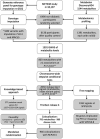Genome-wide association studies of metabolites in Finnish men identify disease-relevant loci
- PMID: 35347128
- PMCID: PMC8960770
- DOI: 10.1038/s41467-022-29143-5
Genome-wide association studies of metabolites in Finnish men identify disease-relevant loci
Abstract
Few studies have explored the impact of rare variants (minor allele frequency < 1%) on highly heritable plasma metabolites identified in metabolomic screens. The Finnish population provides an ideal opportunity for such explorations, given the multiple bottlenecks and expansions that have shaped its history, and the enrichment for many otherwise rare alleles that has resulted. Here, we report genetic associations for 1391 plasma metabolites in 6136 men from the late-settlement region of Finland. We identify 303 novel association signals, more than one third at variants rare or enriched in Finns. Many of these signals identify genes not previously implicated in metabolite genome-wide association studies and suggest mechanisms for diseases and disease-related traits.
© 2022. The Author(s).
Conflict of interest statement
A.E.L. is an employee and stockholder of Regeneron Pharmaceuticals. L.G. is an employee of Genentech, Inc. and stockholder of Roche. N.O.S. has received research funding from Regeneron Pharmaceuticals unrelated to this work. G.R.W. is a stockholder of Metabolon, Inc. E.B.F. is an employee and stockholder of Pfizer. The remaining authors declare no competing interests.
Figures





References
-
- Wishart DS. Metabolomics for investigating physiological and pathophysiological processes. Physiol. Rev. 2019;99:1819–1875. - PubMed
Publication types
MeSH terms
Grants and funding
- R01 DK093757/DK/NIDDK NIH HHS/United States
- R01 MH105561/MH/NIMH NIH HHS/United States
- R01 DK072193/DK/NIDDK NIH HHS/United States
- T32 HL007081/HL/NHLBI NIH HHS/United States
- R01 DK062370/DK/NIDDK NIH HHS/United States
- UM1 HG008853/HG/NHGRI NIH HHS/United States
- R01 DA048993/DA/NIDA NIH HHS/United States
- P30 DK020572/DK/NIDDK NIH HHS/United States
- U01 DK105561/DK/NIDDK NIH HHS/United States
- UL1 TR002345/TR/NCATS NIH HHS/United States
- P01 HL151328/HL/NHLBI NIH HHS/United States
- ZIA HG000024/ImNIH/Intramural NIH HHS/United States
- R35 GM138121/GM/NIGMS NIH HHS/United States
- R01 DK119380/DK/NIDDK NIH HHS/United States
- U01 DK062370/DK/NIDDK NIH HHS/United States
- R01 GM124061/GM/NIGMS NIH HHS/United States
- R01 HL131961/HL/NHLBI NIH HHS/United States

